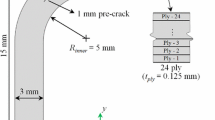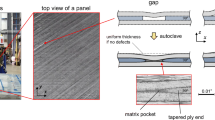Abstract
Composite structures are more susceptible to manufacturing defects than conventional materials. Fiber misalignment, cracks, and voids are typical types of manufacturing defects in laminated composites. Defects can greatly reduce structural integrity and load carrying capacity, so their effects on material and structural strengths must be understood. In this paper, the effect of manufacturing defects on the progressive delamination behavior was studied for carbon/epoxy composite laminated L-beam under four-point bending test conditions. The defects of wavy plies and pure resin that had flowed out were characterized from surface photography and then transformed into finite element modeling using semi-automatic approach to which pre-delamination and void were included. Next, progressive failure analyses were performed with the interface delamination and matrix direction failure accounted for by cohesive zone modeling. Numerical results were examined focusing on the effects of defects on the peak load reduction and the variation of delamination pattern. The stacking sequence effect was also investigated.
Similar content being viewed by others
Abbreviations
- a 0 :
-
Length of pre-delamination
- E :
-
Young’s modulus
- G :
-
Shear modulus
- G IC G IIC :
-
Mode-I and mode-II fracture energy
- Icz :
-
Length of cohesive zone
- I v :
-
Void length
- P :
-
Applied vertical load
- P max :
-
Peak load
- Ri, Ro :
-
Measured inner and outer radii
- R 5/6 :
-
Measured radius of interface 5/6
- r o :
-
Model outer radius
- s :
-
Shift of pre-delamination in length direction
- \(T_n^0,T_s^0\) :
-
Maximum tractions in normal and shear directions
- t :
-
Specimen ply thickness
- t n :
-
Nominal ply thickness
- t r :
-
Pure resin thickness
- t v :
-
Void thickness
- \(\overline {\rm{w}} \) :
-
Applied vertical displacement
- η :
-
B-K mixed mode parameter
- v :
-
Poisson’s ratio
References
A. Makeev, Y. Nikishkov, G. Seon and E. Armanios, Effects of defects on interlaminar performance of composites, Proc. of 39th European Rotorcraft Forum, Moscow, Russia (2013).
D. S. Cairns, J. W. Nelson, K. Woo and D. Miller, Progressive damage analysis and testing of composite laminates with fiber waves, Composites Part A: Applied Science and Manufacturing, 90 (2016) 51–61.
M. Mehdikhani, L. Gorbatikh, I. Verpost and S. V. Lomov, Voids in fiber-reinforced polymer composites: A review on their formation, characteristics, and effects on mechanical performance, Journal of Composite Materials, 53 (12) (2019) 1579–1669.
K. D. Potter, Understanding the origins of defects and variability in composite manufacture, Proc. of the 17th International Conference on Composite Materials, Edinburgh, UK (2009) 27–31.
H. M. Hsiao and I. M. Daniel, Effect of fiber waviness on stiffness and strength reduction of unidirectional composites under compressive loading, Composites Science and Technology, 56 (5) (1996) 581–593.
K. T. Kedward, R. S. Wilson and S. K. McLean, Flexure of simply curved composite shapes, Composites, 20 (6) (1989) 527–536.
R. Martin and W. Jackson, Damage prediction in cross-plied curved composite laminates, Composite Materials: Fatigue and Fracture, W. Stinchcomb and N. Ashbaugh (ed.), West Conshohocken, PA: ASTM International, 4 (1993) 105–126.
M. Hajianmaleki and M. S. Qatu, Vibrations of straight and curved composite beams: A review, Composite Structures, 100 (2013) 218–323.
B. Gozluklu and B. Coker, Modeling of the dynamic delamination of L-shaped unidirectional laminated composites, Composite Structures, 94 (4) (2012) 1430–1442.
V. H. Truong, K. H. Nguyen, S. S. Park and J. H. Kweon, Failure load analysis of C-shaped composite beams using a cohesive zone model, Composite Structures, 184 (15) (2018) 581–590.
T. N. Geleta, K. Woo and B. Lee, Delamination behavior of L-shaped laminated composites, Int. J. Aeronautical and Space Sciences, 19 (2) (2018) 363–374.
D. Cao, H. Hu, Q. Duan, P. Song and S. Li, Experimental and three-dimensional numerical investigation of matrix cracking and delamination interaction with edge effect of curved laminated composites, Composite Structures, 225 (2019).
J. Lua, D. C. Pham, A. Sadeghirad, A. Karuppiah, X. Cui, W. Seneviratne and N. D. Phan, Characterization of fabrication induced defects and assessment of their effects on integrity of composite structures, Proc. of AHS International 74th Annual Forum & Technology Display, Phoenix, AZ, USA, May 14–17 (2018).
B. Tasdemir and D. Coker, Comparison of damage mechanism in curved composite laminates under static and fatigue loading, Composite Structures, 213 (2019) 190–203.
ASTM, Standard test method for measuring the curved beam strength of a fiber-reinforced polymer-matrix composite, ASTM Standard D6415-06, American Society for Testing and Materials, PA, USA (2013).
Abaqus 6.14 Documentation, Dassault Systems, Providence, RI (2014).
A. Turon, C. G. Davila, P. P. Camanho and J. Costa, An engineering solution for mesh size effects in the simulation of delamination using cohesive zone models, Engineering Fracture Mechanics, 74 (10) (2007) 1665–1682.
Hexcel 8552 AS4 Unidirectional Prepreg at 190 gsm & 35% RC Qualification Material Data Report, CAM-RP-2010-002 Rev A (2011).
F. Naya, C. Gonzalez, C. S. Lopes, S. Van der Been and J. LLorca, Combined multi-scale simulations in fiber-reinforced composites, Proc. of 16th European Conference on Composite Materials, Seville, Spain, 22–26June (2014).
C. S. Lopes, P. P. Camanho, Z. Gurdal, P. Maimi and E. V. Gonzalez, Low-velocity impact damage on dispersed stacking sequence laminates. Part II: Numerical simulations, Composite Science and Technology, 69 (2009) 937–947.
D. Liu, Impact-induced delamination — A view of bending stiffness mismatching, Journal of Composite Materials, 22 (7) (1988) 674–692.
C. C. Chamis, Simplified composite micromechanics equations for hygral, thermal and mechanical properties, NASA TM 83320 (1983).
M. L. Benzeggagh and M. Kenane, Measurement of mixed-mode delamination fracture toughness of unidirectional glass/epoxy composites with mixed-mode bending apparatus, Composite Science and Technology, 56 (1996) 439–449.
Z. Niu, H. Suzuki, Y. Ohtake and T. Michikawa, Mesh generation of porous metals from X-ray computed tomography volume data, Journal of Mechanical Science and Technology, 28 (7) (2014) 2445–2451.
Author information
Authors and Affiliations
Corresponding author
Additional information
Kyeongsik Woo is a Professor of School of Civil Engineering at Chungbuk National University, Korea. He received his Ph.D. in Aerospace Engineering from Texas A&M University. His research interests include textile composites, fracture simulation using CDM and CZM methods, high velocity impact behavior of composite materials, effect of defects in composite materials and fluid-structure interaction problems.
Biruk Fikre Nega received his B.Sc. degree in Civil and Urban Engineering from Arba Minch University, Ethiopia (2013) and M.Eng. in Computational Structural Engineering from Chungbuk National University, Korea (2018). Currently he is a Ph.D. student in the Department of Mechanical, Materials and Manufacturing Engineering at the University of Nottingham, Ningbo, China. His research interests are directed fiber preforming processes and predictive computational modeling of laminated, textile and discontinuous fiber composite under static and dynamic loading conditions.
Douglas S. Cairns is the Lylse A. Wood Distinguished Professor at Montana State University. He has over 39 years’ experience in the design, analysis, manufacturing, and testing of composite materials and structures. He received his Ph.D. from MIT Aeronautics and Astronautics, scale and M.S. M.E. and BSME from University of Wyoming.
Rights and permissions
About this article
Cite this article
Woo, K., Nega, B.F., Cairns, D.S. et al. Delamination behavior of L-shaped composite beam with manufacturing defects. J Mech Sci Technol 34, 3709–3720 (2020). https://doi.org/10.1007/s12206-020-0823-y
Received:
Revised:
Accepted:
Published:
Issue Date:
DOI: https://doi.org/10.1007/s12206-020-0823-y




